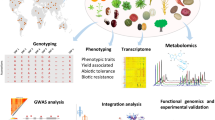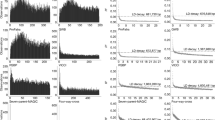Abstract
The use of molecular markers to study genetic diversity represents a breakthrough in this area, because of the increase in polymorphism levels and phenotypic neutrality. Codominant markers, such as microsatellites (SSR), are sensitive enough to distinguish the heterozygotes in genetic studies. Despite this advantage, there are some studies that ignore this feature and work with encoded data because of the simplicity of the evaluation, existence of polyploids and need for the combined analysis of different types of molecular markers. Thus, our study aims to investigate the consequences of these encodings on simulated and real data. In addition, we suggest an alternative analysis for genetic evaluations using different molecular markers. For the simulated data, we proposed the following two scenarios: the first uses SNP markers, and the second SSR markers. For real data, we used the SSR genotyping data from Coffea canephora accessions maintained in the Embrapa Germplasm Collection. The genetic diversity was studied using cluster analysis, the dissimilarity index, and the Bayesian approach implemented in the STRUCTURE software. For the simulated data, we observed a loss of genetic information to the encoded data in both scenarios. The same result was observed in the coffee studies. This loss of information was discussed in the context of a plant-breeding program, and the consequences were weighted to germplasm evaluations and the selection of parents for hybridization. In the studies that involved different types of markers, an alternative to the combined analysis is discussed, where the informativeness, coverage and quality of markers are weighted in the genetic diversity studies.





Similar content being viewed by others
References
Baird NA, Etter PD, Atwood TS, Currey MC, Shiver AL, Lewis ZA, Selker EU, Cresko WA, Johnson EA (2008) Rapid SNP discovery and genetic mapping using sequenced RAD markers. PLoS One 3:e3376. doi:10.1371/journal.pone.0003376
Baruah A, Naik V, Hendre PS, Rajkumar R, Rajendrakumar P, Aggarwal RK (2003) Isolation and characterization of nine microsatellite markers from Coffea Arabica L., showing wide cross-species amplifications. Mol Ecol Notes 3:647–650
Belaj A, Satovic Z, Cipriani G, Baldoni L, Testolin R, Rallo L, Trujillo I (2003) Comparative study of the discriminating capacity of RAPD, AFLP and SSR markers and of their effectiveness in establishing genetic relationships in olive. Theor Appl Genetics 107:736–744
Bhat PR, Krishnakumar V, Hendre PS, Rajendrakumar P, Varshney RK, Aggarwal RK (2005) Identification and characterization of expressed sequence tags-derived simple sequence repeats markers from robusta coffee variety ‘CxR’ (an interspecific hybrid of Coffea canephora x Coffea congensis). Mol Ecol Notes 5:80–83
Bonin A, Ehrich D, Manel S (2007) Statistical analysis of amplified fragment length polymorphism data: a toolbox for molecular ecologists and evolutionists. Mol Ecol 16:3737–3758
Bruvo R, Michiels NK, D’Souza TG, Schulenburg H (2004) A simple method for the calculation of microsatellite genotype distances irrespective of ploidy level. Mol Ecol 13:2101–2106
Combes MC, Andrzejewski S, Anthony F, Bertrand B, Rovell P, Graziosi G, Sashermes P (2000) Characterization of microsatellites loci in Coffea arabica and related coffee species. Mol Ecol 9:1171–1193
Coulibaly I, Revol B, Noirot M, Poncet V, Lorieux M, Carasco-Lacombe C, Minier J, Dufour M, Hamon P (2003) AFLP and SSR polymorphism in a Coffea interspecific backcross progeny [(C heterocalyx x C. canephora) x C. canephora]. Theor Appl Genet 107:1148–1155
Cruz CD (2013) GENES—a software package for analysis in experimental statistics and quantitative genetics. Acta Sci 35:271–276
Cruz CD, Medeiros FF, Pessoni LA (2011) Biometria aplicada ao estudo de diversidade genética. Viçosa, MG
De Silva HN, Hall AJ, Rikkerink E, McNeilage MA, Fraser LG (2005) Estimation of allele frequencies in polyploids under certain patterns of inheritance. Heredity 95:327–334
Dice LR (1945) Measures of the amount of ecologic association between species. Ecology 26:297–302
Diniz EC, Sakiyama NS, Lashermes P, Caixeta ET, Oliveira ACB, Zambolim EM, Loureiro ME, Pereira AA, Zambolim L (2005) Analysis of AFLP markers associated to the Mex-1 resistance locus in Icatu progenies. Crop Breed Appl Biotechnol 5:387–393
Earl D, vonHoldt B (2012) STRUCTURE HARVESTER: a website and program for visualizing STRUCTURE output and implementing the Evanno method. Conserv Genetics Resour 4:359–361
Elshire RJ, Glaubitz JC, Sun Q, Poland JA, Kawamoto K, Buckler ES, Mitchell SE (2011) A robust, simple genotyping-bysequencing (GBS) approach for high diversity species. PLoS One 6:e19379. doi:10.1371/journal.pone.0019379
Evanno G, Regnaut S, Goudet J (2005) Detecting the number of clusters of individuals using the software STRUCTURE: a simulation study. Mol Ecol 14:2611–2620
Falush D, Stephens M, Pritchard JK (2007) Inference of population structure using multilocus genotype data: dominant markers and null alleles. Mol Ecol Notes 7:574–578
Ferrão LFV, Caixeta ET, Souza FD, Zambolim EM, Cruz CD, Zambolim L, Sakiyama NS (2013) Comparative study of different molecular markers for classifying and establishing genetic relationships in Coffea canephora. Plant Syst Evol 299:225–238
Gallego FJ, Perez MA, Nunez Y, Hidalgo P (2005) Comparison of RAPDs, AFLPs and SSR markers for the genetic analysis of yeast strains of Saccharomyces cerevisiae. Food Microbiol 22:561–568
Ramos HCC, Pereira MG, Goncalves LSA, do Amaral AT, Scapim CA (2011) Comparison of multiallelic distances for the quantification of genetic diversity in the papaya. Acta Sci Agron 33:59–66
Jaccard P (1908) Nouvelles recherches sur la distribution florale. Bull Soc Vaudoise Des Sci Nat, 223–270
Jaccoud D, Peng K, Feinstein D, Kilian A (2001) Diversity arrays: a solid state technology for sequence information independent genotyping. Nucl Acids Res 29:E25
Karp A, Kresovich S, Bhat K, Ayad W, Hodgkin T (1997) Molecular tools in plant genetic resources conservation: a guide to the technologie. International Plant Genetic Resources Institute, Rome
Kosman E, Leonard KJ (2005) Similarity coefficients for molecular markers in studies of genetic relationships between individuals for haploid, diploid, and polyploid species. Mol Ecol 14:415–424
Lamia K, Hedia B, Jean-Marc A, Neila TF (2010) Comparative analysis of genetic diversity in Tunisian apricot germplasm using AFLP and SSR markers. Sci Horticult 127:54–63
Laurentin H (2009) Data analysis for molecular characterization of plant genetic resources. Genetic Resour Crop Evol 156:277–292
Leroy T, Marraccini P, Dufour M, Montagnon C, Lashermes P, Sabau X, Ferreira LP, Jourdan I, Pot D, Andrade AC, Glaszmann JC, Vieira LG, Piffanelli P (2005) Construction and characterization of a Coffea canephora BAC library to study the organization of sucrose biosynthesis genes. Theor Appl Genet 111:1032–1041
Markwith SH, Stewart DJ, Dyer JL (2006) TETRASAT: a program for the population analysis of allotetraploid microsatellite data. Mol Ecol Notes 6:586–589
Missio RF, Caixeta ET, Zambolim EM, Zambolim L, Cruz CD, Sakiyama NS (2010) Polymorphic information content of SSR markers for Coffea spp. Crop Breed Appl Biotechnol 10:89–94
Mohammadi SA, Prasanna BM (2003) Analysis of genetic diversity in crop plants—salient statistical tools and considerations. Crop Sci, 1235–1248
Moncada P, McCouch S (2004) Simple sequence repeat diversity in diploid and tetraploid Coffea species. Genome 47:501–509
Nei M (1973) Analysis of gene diversity in subdivided populations. Proc Natl Acad Sci USA 70:3321–3323
Obbard DJ, Harris SA, Pannell JR (2006) Simple allelic-phenotype diversity and differentiation statistics for allopolyploids. Heredity 97:296–303
Polland JA, Rife T (2012) Genotyping-by-sequencing for plant breeding and genetics. The Plant Genome 5:3
Poncet V, Hamon P, Minier J, Carasco C, Hamon S, Noirot M (2004) SSR cross-amplification and variation within coffee trees (Coffea spp.). Genome 47:1071–1081
Pritchard JK, Stephens M, Donnelly P (2000) Inference of population structure using multilocus genotype data. Genetics 155:945–959
Rambaut A (2006) Tree figure drawing tool version 1.3.1. Institute of Evolutionary Biology, University of Edinburgh, UK
Guichoux E, Lagache L, Wagner S, Chaumeil P, Leger P, Lepais O, Lepoittevin C, Malausa T, Revardel E, Salin F, Petit RJ (2011) Current trends in microsatellite genotyping. Mol Ecol Resour 11:591–611
Rovelli P, Mettulio R, Anthony F, Anzuetto F, Lashermes P, Graziosi G (2000) Microsatellites in Coffea arabica L. In: Sera T, Soccol CR, Pandey A and Roussos S (eds) Coffee biotechnology and quality. Kluwer Academic Publishers, Dordrecht, pp 123–133
Russell JR, Fuller JD, Macaulay M, Hatz BG, Jahoor A, Powell W, Waugh R (1997) Direct comparison of levels of genetic variation among barley accessions detected by RFLPs, AFLPs, SSRs and RAPDs. Theor Appl Genet 95:714–722
Serang O, Mollinari M, Garcia AA (2012) Efficient exact maximum a posteriori computation for bayesian SNP genotyping in polyploids. PLoS One 7:e30906
Smouse PE, Peakall R (1999) Spatial autocorrelation analysis of individual multiallele and multilocus genetic structure. Heredity 82:561–573
Sokal RR, Michener CD (1958) A statistical method for evaluating systematic relationships. Univ Kansas Sci Bull, 1409–1438
Souframanien J, Gopalakrishna T (2004) A comparative analysis of genetic diversity in blackgram genotypes using RAPD and ISSR markers. Theor Appl Genet 109:1687–1693
Souza FF (2011) Estudos sobre a diversidade, estrutura populacional, desequilíbrio de ligação e mapeamento associativo em Coffea canephora Pierre ex Froehner, Dissertation of Universidade Federal de Viçosa, Viçosa, Brazil
Ewens WJ, Spielman, RS (1995) The transmission/disequilibrium test: history, subdivision, and admixture. Am J Hum Genet 57:455–64
VAN Puvvelde K, VAN Geert A, Triest L (2010) atetra, a new software program to analyse tetraploid microsatellite data: comparison with tetra and tetrasat. Mol Ecol Resour 10:331–334
Varshney RK, Chabane K, Hendre PS, Aggarwal RK, Graner A (2007) Comparative assessment of EST-SSR, EST-SNP and AFLP markers for evaluation of genetic diversity and conservation of genetic resources using wild, cultivated and elite barleys. Plant Sci 173:638–649
Wright S (1965) The interpretation of population-structure by F-statistics with special regard to systems of mating. Evolution, 395–420
Wright S (1978) Evolution and the genetics of populations. Univ. Chicago Press, Chicago
Acknowledgments
The authors thank Dr. Romário G. Ferrão, Dr. Abrãao C. Verdin-Filho and Paulo Volpi for giving us additional coffee samples from the Capixaba Research Institute—Technical Assistance and Rural Extension (Instituto Capixaba de Pesquisa, Assistência Técnica e Extensão Rural -Incaper). We also thank Milton M. Santos, João Maria Diocleciano and Gilvan O. Ferro for the technical support at Embrapa Experimental Station, in Rondônia, and, Rejane L. Freitas, Telma Fallieri and Tesfahun A. Sotetaw for the technical support at UFV laboratory, in Viçosa. This work was financially supported by Consórcio Brasileiro de Pesquisa e Desenvolvimento do Café, Agrofuturo—Embrapa and National Council of Scientific and Technological Development (CNPq).
Author information
Authors and Affiliations
Corresponding author
Rights and permissions
About this article
Cite this article
Ferrão, L.F.V., Caixeta, E.T., Cruz, C.D. et al. The effects of encoding data in diversity studies and the applicability of the weighting index approach for data analysis from different molecular markers. Plant Syst Evol 300, 1649–1661 (2014). https://doi.org/10.1007/s00606-014-0990-3
Received:
Accepted:
Published:
Issue Date:
DOI: https://doi.org/10.1007/s00606-014-0990-3




